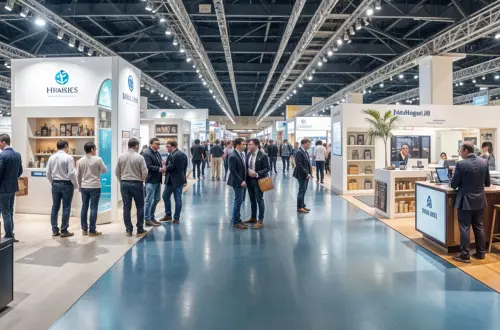TEFAF 2022 – The Outstanding And Thrilling Return Of The Leading Art Exhibition
TEFAF Maastricht 2022 marked the outstanding return of the fair to live renditions. The event, whose 35th edition took place between 24.06.2022 and 30.06.2022, featured 242 exhibitors. Organisers held TEFAF Maastricht 2022 as a hybrid event. The Maastricht Exhibition & Congress Center did not feature Covid-19 safety measures.
TEFAF Maastricht 2022 was a hybrid event – a face-to-face trade fair and a digital platform. The virtual platform featured a variety of services. Among them were online exhibitor booths. The Maastricht Exhibition & Congress Center did not feature strict Covid-19 safety measures. This was because the country removed its national restrictions.
TEFAF Maastricht 2022 featured several highlights as part of the support schedule. These were the:
- TEFAF Talks
- TEFAF Concert
- TEFAF Meet the Experts
- Maastricht Art & Icons Walk
- TEFAF exhibition and the acquisitions conducted during the sub-event
Each focused on a specific goal.
The TEFAF Talks featured a diverse range of topics. Among them were the current issues in the industry. The programme comprised panel discussions led by expert content partners. They enabled attendees to expand their art knowledge. The highlights of the programme included:
- The current issues and future decision-making strategies for conservation
Three leading speakers were present at the panel discussion:
- Dr Mirjam Neumeister, Chief Curator of Flemish Baroque Paintings at Alte Pinakothek
- Dr Cecilia Gauvin, Conservation Scientist and CEO of S-MA-C-H
- Lydia Beerkens, Managing Director of SRAL
The moderator of the debate was Kate Seymour. The speakers debated the key factors that should influence conservation-related decisions. This includes involving as many specialists from different backgrounds as possible. This incorporates the perspective and input of conservatories, art historians and conservation scientists.
- The advantages and pitfalls of museum deaccessioning
The discussion focused on the merits and issues of deaccessioning public museums. It also discussed the implications of such an option for the donors and the public. Three experts from different backgrounds provided their perspectives on the task. The speakers were:
- Melania Gerlis, a writer from Financial Times
- Tom Loughman, former director of Wadsworth Atheneum
- Martin Gammon, the president of Pergamon Art Group
The panel discussion's moderator was Jan Dalley, art editor for the Financial Times.
Similar in intent was the highlight known as the TEFAF Meet the Experts. It comprised interactive conversations about the various presented artworks. The programme featured sessions such as:
- Van Gogh Exposed. Learning about the Artists’ Technique through Restoration Research
Discussed the restoration research on Vincent van Gogh’s “Poplars near Nueren”. This is an oil on canvas with dimensions 78 × 98 cm. It was the artist's first work to be donated to a public museum collection. During TEFAF, the work was displayed pre-restoration.
- The Horizon as the Limit of Our Perception. The World from the perspective of Artist JCJ Vanderheyden.
Discussed the works of Jacques (JCJ) Vanderheyden (1928 – 2012). He was one of the most unconventional Dutch artists of his time. JCJ Vanderheyden dedicated his life to investigating visual perspective dimensions and space. One of the leading examples of his works is the “Horizon” series displayed in the TEFAF Collector’s Lounge.
- The Sacred and Profane in Renaissance Venice with Vittore Carpaccio
Vittore Carpaccio (c. 1460–1525/1526) was one of Giovanni Bellini’s pupils. Renowned for his large-scale paintings that depicted 1490s Ottoman Asian and Venetian life. An early panel created by the artist was the focus of the session. It features a Bellinesque convention of a Madonna and Child. Two female saints, modelled after contemporary aristocratic Venetian ladies, accompany it. They likely were attendants to St. Ursula in the painting cycle describing her life.
- The alluring marble of Saint Sebastian by Diego de Siloe – reconsidering the Spanish Renaissance.
Diego de Siloe (ca. 1495–1563)’s arrival in Naples marked a turning point for the Spanish Renaissance master’s career. It signified the period during which he would infuse his works with the various stylistic elements he had absorbed during his travels. This is best exemplified by the marble statue of Saint Sebastian, circa 1514-15. After TEFAF, the statue will be exhibited as part of the Other Renaissance exhibition.
- Drawn, Printed, and Pasted. Ingres, the Master Draughtsman Across Media
The session focused on presenting the uniqueness of “The Gatteaux Family”. This is a graphic work created by Jean-Auguste-Dominique Ingres (Montauban 1780–Paris 1867). The artwork is one of Ingres' most ambitious portrait groups and one of their most significant works on paper. It was completed in 1849 and is dedicated to one of Ingres’ closest friends, Edouard Gatteaux, and his parents. The work comprises three engravings, each created from earlier portrait drawings. It remained in the Gatteaux family and its descendants’ collection until 1931.
- ‘Japonisme’. The influence of Asia on the French decorative arts during the age of industry
It discussed the “‘Japonisme’ Patinated Bronze and Cloisonne Enamel Table” by Ferdinand Barbedienne and Edouard Lievre, circa 1870. The work encapsulates the 19th-century French decorative arts' aspirations. During the age of industry, the West held a high fascination for Asian Art. In particular, it viewed such works as otherworldly objects from distant and exotic lands. It also shows the preoccupation of the day with Darwinism and the developing natural sciences. This is reflected in the naturalistic form of the work.
- Into the Blue. The mesmerising transformable jewels of Van Cleef & Arpels
It discussed Van Cleef & Arpels’ Heritage Collection of Jewellery and High Jewellery. The Heritage Collection comprises period pieces crafted between the 1920s and 1990s. Each piece has undergone archival research to trace its history, thus certifying its authenticity. During TEFAF 2022, the exhibitor presented a creation representing the 1960s aesthetic–an exquisite necklace. Among the most notable features of the work is the selection of used gems, including 59 sapphires. Another noteworthy feature is the sources of inspiration used for the concept. They have gained from observing the magnificence of nature and decorative Indian motifs. Like many other works in the Heritage Collection, the piece is transformable. This is achievable by removing part of the composition or wearing it in an alternative location, such as the wrist.
- From Surrealism to Abstraction: A Journey Through Jacqueline Lamba’s Mystical Paintings
Jacqueline Lamba was André Breton’s L’Amour fou, and a lifelong friend of Frida Kahlo and Dora Maar. She studied at the École des Arts Décoratifs and dedicated her life to painting. Beginning her career in Surrealism, she would eventually transition to Abstraction. This transition began in America and continued after her return to France in 1955. Her works from this period featured light brushstrokes that evoke the landscape surrounding the village in Alpes-de-Haute-Provence. A leading example of this transition is the “Untitled” from 1978. It is an oil-on-wood work depicting watery clouds using brushstrokes and curved lines. The blend forms a one-of-a-kind depth forged of dark greens and blues. Reflections highlight them. These have been sketched using lighter touches to portray the inherent movement of nature as the artist follows it peacefully.
- The Art of Japanese Lacquer as displayed by Katsu Hamanaka’s Rare Compositions
The session's focus was Katsu Hamanaka’s “Tray”, created in 1930. Katsu Hamanaka is an artist renowned for his lacquer artworks. He implemented “the ancestral” art of lacquer in his abstract compositions. His works are rare, disappearing altogether in the 1930s. The "Tray" exemplifies his approach in its black vegetal varnish combined with a cubist mosaic of shagreen sheets. These have been treated using the “samenuri” technique.
The TEFAF Concert was one of the lead highlights of the event. It occurred on 28.06.2022 and was organised by Maastricht’s Sint Janskerk. It featured the solo harpist of the Wiener Philharmoniker Anneleen Lenaerts. During the Concert, she performed works from her latest music album. These were interspersed with fragments from Puccini, Richard Strauss, and Dvorak. She also performed orchestral works of Smetana and Liszt.
Among the highlights of the event was the TEFAF exhibition. A total of 7,000 years of art history were presented during the exhibition. There were many notable features among the acquisitions conducted during the sub-event. One of them was the high number of works acquired by museums and institutions. This showed the importance of the event in helping to preserve cultural relics and works. The Musee Royal de Mariemont in Brussels is one such example. They procured an Egyptian sculptor’s trial piece of a kneeling pharaoh from the Ptolemaic Period. The House of European History in Brussels acquired the "L’esprit de Locarno" by Max Ernst. Likewise, the American Museum procured a rare French sculpture of the Virgin Mary and Child. The Museum Rotterdam also acquired artwork from Cornelis Saftleven. It depicts a Cattle Market with the Ruins of Castle Honingen in Kralingen. Museum Boijmans van Beuningen also furthered its collections with the “Da Capo 2022” by Suchan Kinosita.
The exhibition also featured high popularity among the works created by female artists. For instance, among the acquired artworks were the:
- “Virgin of the Chair” by Giovanna Garzoni
- “The Wedding at Cana” by Lavinia Fontana
- “Windscape” by Leiko Ikemura
- “Charting the Invisible” by Georgia Russell
- “Head of a Boy” by Michaeline Wautier
- “Antropic System II” by Emilie Pugh
The exposition also featured a high demand for works created by living artists. Examples include a wood-carved sculpture by Wang Keping and “Iron Root” by Ai Weiwei.
Many of the presented works were acquired by private collectors as well. The leading examples include:
- “The Triumph of Galatea” by Luca Giordano
- “The Old Shepherd” by Michael Sweerts
- “Portrait of Mme. Lucie Gerard” by Giovanni Boldini
- “Pintura marró i ocre” by Antoni Tàpies
- “A Marabou Stork” by Jean-Léon Gérôme
- “The Prodigal Son” by Georges Minne
The high level of acquired books and manuscripts was also among the exhibition's notable features. One such instance was the “Les Voyage de la Nouvelle France Occidentale” by Samuel de Champlain.
Another notable feature was the La Haute Joaillerie exhibitors due to their glittering displays and creative installations. This resulted in many new acquisitions, such as the “Enchanted Lily Brooch in rubellite” by Anna Hu. The contemporary and modern art exhibitors also received ample attention. Among the notable acquisitions within this group was the “Huldigung (Homage)” by Emil Nolde.
The Maastricht Art & Icons Walk was among the high-interest sub-events. It allowed attendees to continue their exploration of notable artworks. They could explore for the task, a guided route through the city with stops at renowned museums, institutions and historical buildings. Maastricht Marketing organised the Maastricht Art & Icons Walk. The Walk featured 29 locations distributed throughout the city, with the starting site being the hosting venue. Among the featured historical and cultural locales were the:
|
|
TEFAF 2022 signified the successful restart of the leading art fair. It featured 242 exhibitors from 20 countries. They represented four continents: Europe, Asia, North, and South America. Among the exhibitor countries with the highest presentation rates were:
|
|
Of the exhibitors, 215 were return participants, and 21 were first-time attendants. According to participating groups, attending the first live edition to take place during the pandemic was thrilling.


